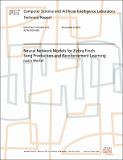Neural Network Models for Zebra Finch Song Production and Reinforcement Learning
Author(s)
Werfel, Justin
DownloadMIT-CSAIL-TR-2004-070.ps (376.0Kb)
Additional downloads
Metadata
Show full item recordAbstract
The zebra finch is a standard experimental system for studying learning and generation of temporally extended motor patterns. The first part of this project concerned the evaluation of simple models for the operation and structure of the network in the motor nucleus RA. A directed excitatory chain with a global inhibitory network, for which experimental evidence exists, was found to produce waves of activity similar to those observed in RA; this similarity included one particularly important feature of the measured activity, synchrony between the onset of bursting in one neuron and the offset of bursting in another. Other models, which were simpler and more analytically tractable, were also able to exhibit this feature, but not for parameter values quantitatively close to those observed.Another issue of interest concerns how these networks are initially learned by the bird during song acquisition. The second part of the project concerned the analysis of exemplars of REINFORCE algorithms, a general class of algorithms for reinforcement learning in neural networks, which are on several counts more biologically plausible than standard prescriptions such as backpropagation. The former compared favorably with backpropagation on tasks involving single input-output pairs, though a noise analysis suggested it should not perform so well. On tasks involving trajectory learning, REINFORCE algorithms meet with some success, though the analysis that predicts their success on input-output-pair tasks fails to explain it for trajectories.
Date issued
2004-11-09Other identifiers
MIT-CSAIL-TR-2004-070
AITR-2004-008
Series/Report no.
Massachusetts Institute of Technology Computer Science and Artificial Intelligence Laboratory
Keywords
AI